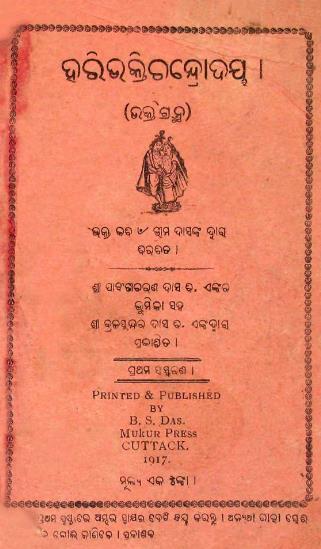Published in 1917, Haribhakti Chandrodaya by Bhima Das is a seminal essay that explores the nature of devotion and spirituality within the framework of Odia culture. As a celebrated poet and thinker, Das uses this work to articulate his philosophical views on devotion to Lord Krishna, drawing from both religious texts and personal reflections. This essay not only highlights the essence of bhakti (devotion) but also serves as an important contribution to Odia literature and spirituality.
Haribhakti Chandrodaya, which translates to the “Rising Moon of Devotion,” presents a rich tapestry of thoughts that celebrate the devotional path toward God, particularly focusing on the worship of Lord Krishna. Das weaves together personal insights, philosophical arguments, and devotional poetry that invites readers to experience a deep emotional connection to spirituality.
The structure of the essay unfolds in a lyrical manner, as Das utilizes poetic language to express complex ideas simply and accessibly. His eloquence reflects a profound understanding of both the intricacies of bhakti and the common person’s spiritual journey, making the essay poignant and relatable.
At the heart of Haribhakti Chandrodaya is the exploration of bhakti as a pathway to spiritual fulfillment. Das emphasizes that true devotion transcends mere ritualistic practices; it is about surrendering oneself to the divine will and cultivating a heartfelt relationship with God. Through personal anecdotes and philosophical discourse, he illustrates the transformative power of love and devotion in overcoming life’s challenges.
The essay also discusses the significance of humility and selflessness in the practice of devotion. Das argues that genuine bhakti requires the aspirant to transcend ego and cultivate an attitude of service and compassion towards others. This message resonates deeply, encouraging readers to reflect on their own spiritual practices and interactions with the world.
Haribhakti Chandrodaya is deeply rooted in the cultural and spiritual milieu of early 20th-century Odisha. During this period, there was a resurgence of interest in spirituality and the devotional traditions that underlie Hindu philosophy. Das’s essay reflects this broader movement, advocating for a return to the essence of faith and devotion, which he believed had become overshadowed by ritualism.
By incorporating elements of Odia folk traditions and local practices, Das grounds his philosophical explorations in the everyday experiences of his readers. This cultural connection enhances the essay’s relevance, as it speaks directly to the spiritual aspirations of the Odia people.
Beyond its thematic richness, Haribhakti Chandrodaya is also significant for its contribution to Odia literature. Das’s poetic style, infused with devotional fervor, adds a unique dimension to the essay. His ability to blend prose and poetry captures the emotional essence of bhakti, making the text not only insightful but also aesthetically pleasing.
Moreover, this work has inspired subsequent generations of writers, poets, and thinkers in Odisha and beyond. Its enduring appeal lies in its ability to evoke a sense of longing for the divine while offering practical insights into the practice of devotion.
Books Info
| Books name | Haribhakti Chandrodaya / ହରିଭକ୍ତି ଚନ୍ଦ୍ରୋଦୟ |
| Author | Bhima Das |
| No Of pages | 138 |
| Publisher | Sri Brajasundar Das |
| Publication | 1917 |
| Printed At | Mukur Press |
| Distributor | NA |

